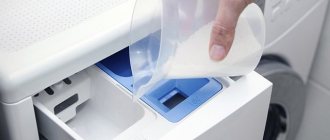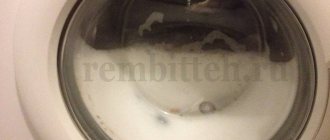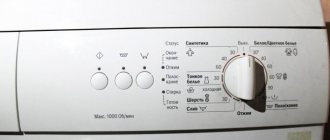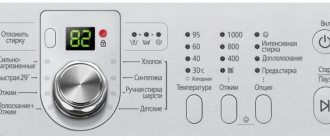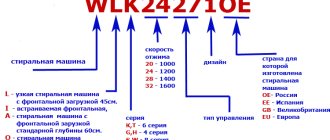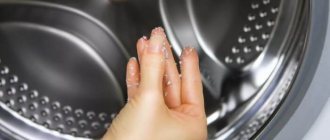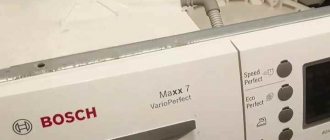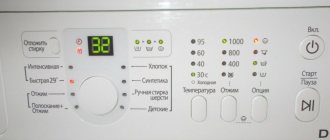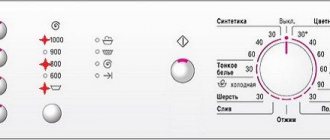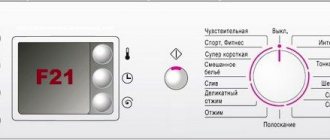When buying a washing machine, you should focus on several basic parameters that determine its class: size and type of load, washing efficiency, spin type and energy efficiency. Knowledge about each of these criteria will ultimately help you choose the optimal model that will serve its owner for many years and will suit him not only visually, but also technically.
- Generally accepted classification
- Why do they give an "A" grade?
- Washing class
- Spin class
- Energy class
- Types by size and loading
- Is drying necessary?
- Additional functions
- What to look for when purchasing
- Catalog of washing machines with reviews
Generally accepted classification
Are you using citric acid?
Oh yes! No
You can understand the quality of the washing machine in front of you by focusing on a special classification developed by European countries. Models of this type of household appliances are evaluated according to three main indicators: energy consumption, washing quality and spin performance.
In all of these parameters there is a gradation by class, where “A” is the highest grade and “G” is the lowest. Each vehicle parameter is assigned 7 ratings:
- “A” and “B” are excellent and good grades, respectively;
- “B” and “C” – very good and not bad;
- “D” and “E” – normal and satisfactory;
- "F" and "G" are bad and very bad.
General classification
It turns out that any machine will receive at least three ratings. The latest options are practically not produced, and it is also unlikely that anyone would want to purchase equipment that is already known to be ineffective. But if, nevertheless, such a model is found on the consumer market, then there is no need to buy it.
It is worth paying attention to the fact that the classification system is only a basis that changes and is modernized over time. Thus, depending on the parameter of energy efficiency and washing, new classes have appeared: “A+”, “A++” and also “A+++”.
Help: determining the class of the selected model is not difficult even for a beginner - this data is located on a special sticker on the body of the machine. Usually the manufacturer does not hide them, but on the contrary, makes them most noticeable.
Selection rules
What is worth remembering before going to the store:
As mentioned above, the efficiency of washing clothes depends on the class of the washing machine
In principle, there is not such a big difference between A and B (except that B is cheaper, but in terms of efficiency they are almost equal), but regarding the class below C, it is worth thinking carefully about the importance of just such an acquisition. You will save on a purchase once, but subsequently you will pay more for the energy consumed and, as a result, the initial savings will come to naught. If you are lost in the store and don’t know which model is better and how they differ from each other, look for information on the case
It is there that manufacturers usually indicate all the necessary information - the volume of laundry, classes, and so on. Every year a number of new models appear, here manufacturers spoil us on the one hand, but on the other hand they confuse us, because the larger the model range, the more difficult the choice. The more modern the machine, the more economical it is.
Determine for yourself in advance what to pay attention to, and then your purchase will be successful.
Why do they give an "A" grade?
For any of the parameters (washing efficiency, spinning and energy consumption), a rating of “A” or “very good” is top notch. It is placed if the SMA performs the specified function at a high level:
- Washing class “A” is assigned if the machine removes all stains and is as efficient as possible.
- Spin class “A” is assigned depending on the residual moisture content of the laundry (in this case it should not exceed 45%).
- In terms of energy efficiency, the most economical washing machine in terms of energy consumption receives an “A” rating.
Class A+++
Optimal speed settings for different materials
Not all materials are subject to standard washing. For certain types of fabrics, a mode such as delicate washing will be required. As a rule, on modern models of washing machines you can set the required number of revolutions. Rotating the motor too quickly can damage some tissues.
Linen, jeans, cotton, calico
For denim and cotton fabrics, the permissible value is 800 rpm. It is also recommended to activate the delicate wash cycle. Linen is an extremely delicate material, so the spin cycle is either turned off or activated at a minimum number of revolutions.
Satin, silk
Satin, silk items, as well as tulle, must be washed at 600 rpm, since these are quite thin and delicate materials. If there is such a possibility, then the spin is turned off.
Wool
It is not recommended to wring out wool items. If this option is not available, it is recommended to set the minimum spin value (no more than 400 rpm).
Washing class
One of the main functions of a washing machine is to combat stains on fabric. The efficiency indicator for this parameter just demonstrates the washing class. There is also a generally accepted gradation from “A” (washing is very good) to level “G” (very weak).
A completely logical question arises: why is this or that technique awarded a certain class? Naturally, it is possible to determine how well SMA erases only under experimental conditions. IN
As a starting point, a standard machine is taken, which copes with this no better or worse than others, but always shows a constant result. Under the same conditions, on the same piece of fabric, a test is carried out, based on the results of which a verdict is made:
- The highest score, or “A” rating, is given to a machine whose washing class is defined as excellent (its efficiency index is 1.3).
- Very good wash o (index – from 1 to 1.3).
- A good wash is assigned class “C” (index – from 0.97 to 1).
- Normal is designated by the letter “D” (index – from 0.94 to 0.97).
- Satisfactory is “E” (index – 0.91 to 0.94).
- The bad one gets o (index – from 0.88 to 0.91).
- Very poor washing o (index – 0.88-0).
Expert opinion
I work in the household appliance repair industry. Extensive experience in restoring washing machines and dishwashers.
Ask a Question
Important! Today, manufacturers have begun to produce a new generation of washing equipment with a washing class of “A+” and higher, however, their price can be much more expensive. But is such a machine worth the money? Practice shows that in the issue of washing efficiency, not only the machine itself plays an important role, but also the cleaning agent and the nature of the contamination. That is, you can simply use a good powder - and equipment with class “C” will cope with stains on clothes no worse than machines marked with the signs “A” and “B”. That is, this factor matters, but there is no need to chase the highest rating and overpay.
Spin class
An important parameter for washing equipment is the spin class. It shows as a percentage how wet your items will be after washing. This indicator directly depends on the number of revolutions of the machine per minute. That is, the more often the drum rotates, the drier things will be.
The percentage of humidity can be easily calculated - it is the ratio of the weight of the laundry before and after the washing process. Depending on the spin class, washing machines are assigned ratings from “A” to “G”, each of them corresponds to a certain humidity and speed:
- The best spin quality is marked with the letter “A”, with which the residual moisture content of the laundry will be less than 45%.
- The “B” value indicates that after spinning the fabric will remain 45-54% damp.
Do you wash by hand?Oh yes! No
- “C” means that the technique will spin the laundry, leaving it at 54-63%.
- A value of 63-72% guarantees class “D”.
- “E” means that after washing the items will be 72-81% damp.
- “F” corresponds to a result of 81-90%.
- A machine with class “G” after washing will show the laundry humidity to be more than 90%.
In addition, the spin efficiency depends on the diameter of the drum and the time it takes to complete the full spin cycle. The longer the time and the larger the drum, the drier the laundry will be.
The dryness of the fabric is also affected by the permeability of the material. So, a chiffon blouse and jeans after washing together will have a different percentage of moisture.
Important! A higher spin class is not always good. Strong - will deform the fabric. Obviously, for regular washing of ordinary and delicate materials, class “D” is quite suitable. It is believed that machines with 1000 - 1200 drum revolutions per minute are suitable for any laundry.
Most modern washing machines have several spin modes programmed into them; this is also worth paying attention to when purchasing.
Proportion of dry fabric depending on class
What will European indices tell you?
First of all, you should understand what the spin class in washing machines is. This is considered to be one of the most important parameters for evaluating modern models. It characterizes the percentage of moisture remaining in washed items. This indicator depends on the number of drum revolutions per second - the higher the speed, the drier the things.
To calculate the effectiveness of this process at home, you need to weigh the wrung out laundry, dry it and weigh it again. Then you should make a simple calculation: subtract the weight of the dried laundry from the weight of the wet, divide the result by the weight of the dry items and multiply by 100%.
For example, after washing you weighed the laundry, it turned out to be 5 kg. After drying, its weight decreased to 3 kg. As a result of subtraction, we get the number 2. Divide it by 3 - it comes out to 0.66. We multiply the fraction by 100% - it turns out that the percentage of humidity is 66%.
Spin efficiency classes
Fortunately, when purchasing equipment in a store, you don’t have to count anything yourself. The spin class of the washing machine is usually indicated in the documentation for the model. It is classified by indices from A to G. This is a European quality standard for drying clothes, which is accepted throughout the world. Each indicator indicates how dry your items will be after finishing washing. Let's take a closer look at the classification:
- G – the percentage of moisture after spinning is above 90%. In such units, the laundry will be only 10% dry at the exit. Number of drum revolutions per minute – 400;
- F – assumes a spin efficiency of 81-90% at a speed of 600 rpm;
- E – percentage of moisture remaining after washing – 72-81%. The equipment of this class will “scroll” the laundry at a speed of 800 revolutions per minute;
- D – 63-72% moisture will remain in things. Speed – 1000 rpm;
- C – will provide spin efficiency of 54-63%. In this case, the drum will spin at a speed of 1200 rpm;
- B – the washing machine spins the laundry at a speed of 1400 rpm, leaving no more than 45-54% moisture in it;
- A – provides the driest spin – no more than 45% moisture remains in things. Speed –1600 rpm.
Energy class
A good washing machine should be economical in energy consumption. The corresponding marking will show how energy-saving it will be:
- “A+” (newest generation) – electricity consumption – 0.17 kW/h.
- Class “A” shows that the machine will consume from 0.17 to 0.19 kW/h.
- In the case of “B”, electricity consumption will range from 0.19 to 0.23 kW/h.
- Class “C” consumption will be from 0.23 to 0.27 kW/h.
- A machine marked “D” will consume between 0.27 and 0.31 kWh.
- Equipment marked “E” will consume from 0.31 to 0.35 kW/h.
- Class “F” washing machine – from 0.35 to 0.39 kW/h.
- The most expensive will be “G” - from 0.39 kW/h.
Expert opinion
I work in the household appliance repair industry. Extensive experience in restoring washing machines and dishwashers.
Ask a Question
Important! The energy consumption class is indicated per kilogram of items. Therefore, in order to calculate the exact value of electricity consumed per wash, you need to multiply the indicated number by the weight of the laundry.
Competition in the car market today is great and manufacturers fight for buyers by constantly modernizing them. The usual classification of cars from seven ratings (“A” – “G”) has long included equipment with the “A+” sign. But the leaders in the production of washing machines do not stop there - in retail chains you can increasingly find models of a higher class.
Example of a tag on a car
Types by size and loading
Based on the type of loading, machines are divided into frontal and vertical. Frontal ones can most often be found in retail chains - this is a familiar technique with a transparent round-shaped door, reminiscent of a porthole. In a top-loading machine, laundry is placed through a special opening at the top.
There is no significant difference in these two models, except for the location of bearings and dimensions. Here everyone finds what is closest to them.
The size is chosen, usually based on the size of the bathroom and washing needs:
- A machine with a width of 32-35 cm and a load of 3 to 4 kg will fit perfectly even in a small room and is suitable for a family of two. Unfortunately, you cannot wash a down jacket or blanket in it.
- Larger equipment with a capacity of 5 to 6 kg and a width of 40-45 cm can easily cope with washing a large item. Accordingly, it is suitable for serving a family of 3-4 people.
Do you wash your shoes in the machine?
Oh yes! No
What criteria are used to determine the best household appliances?
If you look at the ratings of automatic washing machines, you will notice that they differ from each other. This happens because users and experts in their assessments give preference to one or more features that are most important to them. AFM is assessed according to the following criteria:
- design features;
- reliability and durability;
- noise level and washing quality;
- dimensions and maximum weight of loaded laundry;
- washing and spinning class;
- energy consumption class;
- price category.
It is quite difficult to determine which washing machine is better based on the combination of the above indicators.
If we take into account the design features and price factor, then automatic front-loading units are the most common among users. Top-loading machines are less popular among housewives
AFMs differ from each other in size. A small family living in a small apartment will prefer a narrow unit that can hold up to 4 kg of laundry. Medium depth machines are capable of washing from 5 to 7 kg of clothes at a time. Full-size models can wash even more – up to 13 kg.
Budget models from well-known manufacturers are of great interest to buyers. Among them are the best washing machines, which are not inferior in quality to more expensive competitors.
Is drying necessary?
There are times when there is no time or opportunity to dry laundry. And here a machine with a drying function comes to the rescue: after such washing, the items are removed completely dry, without requiring hanging.
But this function also has a number of disadvantages:
- rarely found in washing machines;
- significantly increases the cost (from 20%);
- often dries out laundry.
Efficiency classes
Which brand should you prefer?
Having decided on the functionality that you really need, proceed to solving an equally difficult task - choosing a device brand. How to choose the right washing machine from the manufacturer’s point of view? Even experts do not undertake to definitively answer the question of which brand makes the best washing machines. Any brand of equipment has both pros and cons.
Such popular brands of washing machines as LG, Beko, Indesit, Samsung, Hotpoint Ariston, Candy, Whirpool, Gorenje, Zanussi, Atlant are famous for their fairly good quality and decent functionality. These manufacturers often top sales rankings, because they produce a wide range of equipment designed to suit every taste and budget. The cost varies depending on the set of functions, so the buyer can choose a model in both the budget and mid- or high-price segments.
Some manufacturers lure buyers by offering good service support.
The most popular brands in terms of price and quality ratio are Siemens, Bosch, Electrolux, AEG, Hitachi. The cost of such washing machines may differ markedly from units of the previous category, but this is justified by maximum reliability. Manufacturers focus on high quality assembly and materials, and also offer a large selection of models, including budget lines of washing machines.
It would not be amiss to mention the manufacturers of luxury equipment - Miele, Smeg, Asko, Schulthess. The products of these brands are expensive, but they are of high quality and can last more than 15-20 years. It is usually purchased for professional use, for example, in laundries. Also, the buyer has to overpay for the exclusive design of devices that some brands offer.
Additional functions
Often, equipment sellers try to attract the buyer by listing additional functions of the machine. But what are they and what are they for?
“Quick wash” is the best solution for those who urgently need clean laundry. The cycle in this case lasts from 15 to 30 minutes.
“Delayed start” - a function that helps the car owner save energy. For example, washing starts at night and consumes energy at reduced rates. Or the owner of the equipment simply needs dry laundry at a certain point. You can delay washing from 1 to 24 hours.
“Pre-wash” allows you to remove even stubborn stains. With this function, the laundry is soaked, and then the main cycle is turned on.
“Bio-washing” is a kind of stain removal stage. Before washing, the machine keeps the temperature around 30-40 degrees Celsius so that special granules - enzymes contained in the powder - corrode the dirt.
“Protection against leaks” or “AquaStop” function protects the machine from water leakage after washing. Can be used using: thickened inlet hose, solenoid valve, drip tray. It can be complete or partial.
Are you unplugging your washing machine?
Oh yes! No
What to look for when purchasing
In such a serious matter as choosing a washing machine, you simply need to pay attention to its washing class. But it is not necessary to look for equipment with an “AAA” rating.
For example, in terms of wash quality, you may not even feel any difference between the “A” and “B” ratings. Spin level “C” is quite suitable for weekly laundry care.
The most important parameter, perhaps, remains the energy consumption class. But even in this case, even an indicator at level “A” or “B” will indicate the efficiency of the equipment.
Video
All other factors are selected individually and calculated based on the budget.
